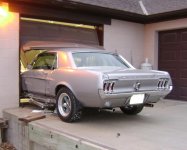franklinair
Well-known member
- Joined
- Mar 1, 2007
- Messages
- 4,744
I'm installing a new Ignition Switch connector w/pigtail.
IIRC the Start position gives 12 V to the Coil+ for starting, and then in the Run position 6V+/- is then furnished to the Coil+ terminal. Correct?
The schematic shows the Pink resistance wire (16A) coming from the Ign switch to the 14401 connector under the dash, and then wire#16B from there to the Coil+ terminal.
Doesn't make sense. If the Pink resistance wire has already decreased the coil's voltage supply, how is the Red/Green wire #16B going to furnish 12V for starting? :undecided Or does the Coil in fact operate on the reduced voltage all the time?
Neil
PS
I'm wiring the car to original specs, but it will be operating a Pertronix Ignition which will require 12V to the Coil. But that's another issue easily solved.
IIRC the Start position gives 12 V to the Coil+ for starting, and then in the Run position 6V+/- is then furnished to the Coil+ terminal. Correct?
The schematic shows the Pink resistance wire (16A) coming from the Ign switch to the 14401 connector under the dash, and then wire#16B from there to the Coil+ terminal.
Doesn't make sense. If the Pink resistance wire has already decreased the coil's voltage supply, how is the Red/Green wire #16B going to furnish 12V for starting? :undecided Or does the Coil in fact operate on the reduced voltage all the time?
Neil
PS
I'm wiring the car to original specs, but it will be operating a Pertronix Ignition which will require 12V to the Coil. But that's another issue easily solved.


